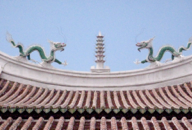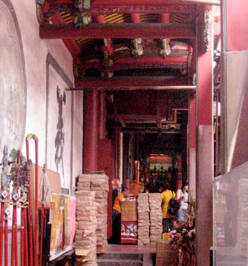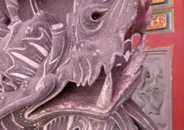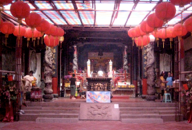tainan grand matsu temple
Tainan, taiwan, republic of china
May 3, 2008


tainan grand matsu temple
Tainan, taiwan, republic of china
May 3, 2008




There are approximately 400 Matsu temples in Taiwan. Matsu, Goddess of the Sea, is also known as “Heavenly Queen” or “Tianhou” in Chinese. During the Xuande reign period (1426-1435) of the Ming Dynasty, the deities of Matsu, from the Fujian Provence of China, were introduced to Taiwan by a eunuch named Wang San-Bao. He built a temple known as Tianfei Temple, or “Heavenly Princess Temple” to worship Matsu. This was before this venerated deity was elevated to the status of queen. Enter, King Ningjing, ninth generation descendent of the Ming Dynasty, who was invited to settle in Taiwan as a “military supervisor” toward the end of the Ming period. Though he lost power in China, he became a symbol of the royal lineage and the Ming court in Taiwan. In 1664, Zheng Jing, the last Ming governor of Taiwan, built King Ningjing a magnificent mansion which contained two halls for worshipping popular deities: Xuantian Shangdi, “God of Northern Heavens”, and Guansheng Dijun, a general of the Three Kingdoms Period. A wise abbot, friend of the King Ningjing, persuaded the king to turn his home into a temple. Consequently, this mansion became the first Tainan Grand Matsu Temple . Nineteen years later, during the Qing Dynasty, General Shi Lang and his army attacked Taiwan. Governor Zheng Jing surrendered. King Ningjing decided to commit suicide as a sacrifice to the Ming Dynasty. In an act of fidelity to the last Ming emperor, his five concubines preceded him into death by hanging themselves. General Shi Lang dismantled the royal administrative offices for matters of the Ming Court officials (“ZongRenFu”) and requested the mansion be used as a Matsu temple, named “Tiafei Temple”. The following year, in 1684, the deity, Matsu was elevated to the status of queen. Tianhou Temple was officially listed in the state records, solidifying the deity’s position. The temple was renovated in 1765, and again, from 1775-78, bringing its structure to its present day appearance. In 1818, the temple suffered from a fire, then toward the end of the Qing dynasty, it suffered from lack of funding and disabuse. The temple was almost auctioned for sale during the Japanese occupation of Taiwan; however, in 1946, it was almost lost, once again, to structural damage caused by an earthquake. The most recent renovation occurred in 1971, where the hall for worshipping the San-Boa Buddha (“The Three Treasure Buddha”) was reconstructed in response to popular demand. The majesty of this temple is in its original structure, the graceful proportions and elegantly curved appearance, which makes it “one of the best designed temples” in Tainan. This temple is replete with architectural ornaments, stone inscriptions, wood carvings, polychrome paintings, and stone carvings. Since 1985, it has been considered to be an historic site of the highest caliber in Tainan and the Minnan area of Taiwan.
PHOTOS: Left Column: 1. A stand of painted wooden halberts used in rituals 2. View of the temple’s interior courtyard, the area of the altar, and the exit corridor. 3. Polychrome details near the ceiling of the temple. 4. View into the outer courtyard of the temple. Center,Top: View from the entry toward the altar of the temple. Note the polychrome carvings, paintings, embroidered fabric hangings and lanterns. Center, Bottom: Exit corridor with polychrome beams and wall frescoes. The aisle is filled with painted wooden halberts and wooden shields with calligraphy. Note the wrapped packages of printed matter cluttering the hallway. Right Column: 1. Dragons on the roof of Grand Matsu Temple. 2. Inner courtyard with bronze incense burner, potted bonsai trees and decorations. 3. Stone carving of sea animals. 4. View toward the altar and incense burner at Grand Matsu Temple.

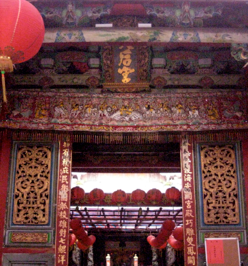
First Official Matsu Temple
